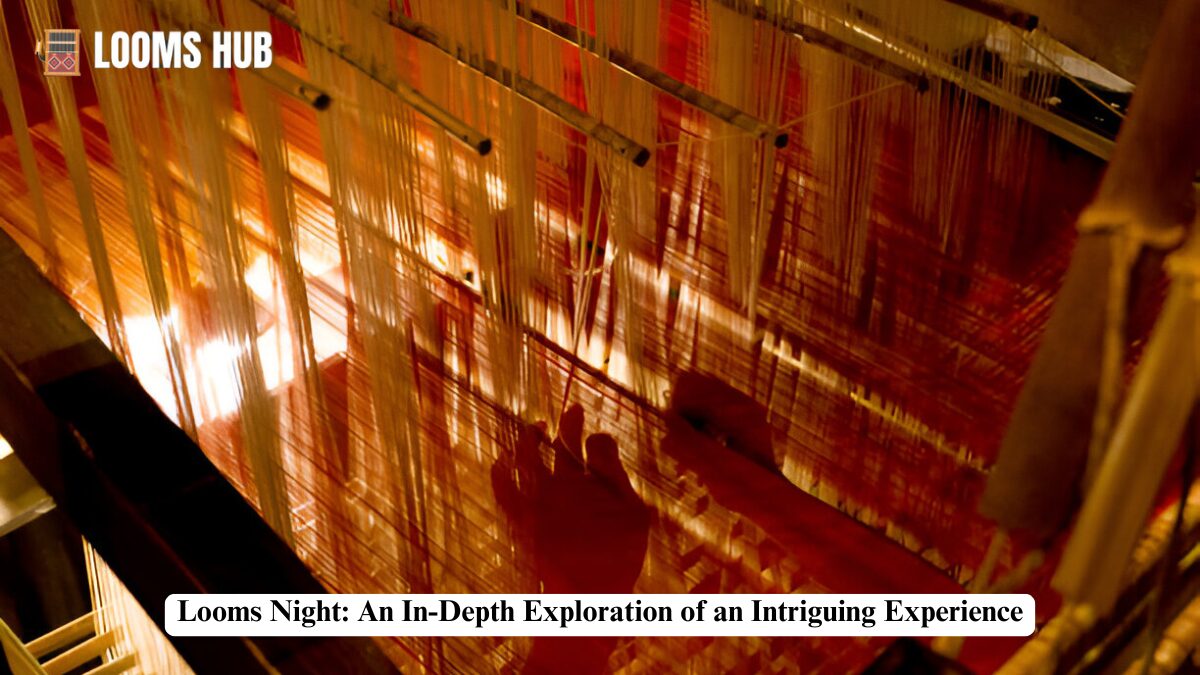Looms Night is not just an event; it’s an immersive celebration that blends tradition, craftsmanship, and culture in a way that few other occasions can. This unique event invites people from all walks of life to experience the richness of artisanal work, the vibrancy of communities, and the magic that comes from gathering under the night sky. But what exactly is Looms Night, and why has it gained so much attention in recent years? In this article, we’ll dive deep into the origins, significance, and evolution of Looms Night, and explore how it has captured the imagination of millions across the globe. Whether you’re a seasoned participant or just curious about this cultural phenomenon, you’ll find everything you need to know right here.
Understanding Looms Night
Definition and Origin of Looms Night
Looms Night is a celebration that honors the art of weaving and textile creation. It’s an event where artisans, designers, and crafters come together to showcase their skills, display their woven creations, and immerse participants in the world of textile arts. The name “Looms Night” refers to the central role that looms — the machines used for weaving — play in this cultural celebration.
While the specifics of Looms Night may vary by region, it is universally recognized as a celebration of creativity and craftsmanship. The tradition dates back hundreds of years, originating in communities where weaving was both a craft and a means of livelihood. Over time, it evolved from a humble gathering into a much larger event, often held during specific times of the year, such as harvest festivals or seasonal changes.
Cultural Significance of Looms Night
The cultural importance of Looms Night lies in its deep-rooted connection to tradition and creativity. For many cultures, weaving is a symbolic act that transcends mere craftsmanship; it represents the interconnectedness of community, heritage, and artistic expression. Looms Night allows participants to reconnect with their roots, celebrate their cultural heritage, and pass down knowledge from one generation to the next.
This event is often a time for storytelling, as artisans weave not only textiles but also tales about their craft and its significance in their lives. Whether it’s creating intricate patterns that tell stories or using specific materials that have been passed down through families, Looms Night fosters a sense of pride and shared history.
Key Elements that Define the Event
While the details of the event vary depending on the location, there are several common features that define Looms Night:
- Artisan Showcase: Looms Night is a platform for artisans to display their work, from traditional handwoven textiles to modern interpretations.
- Live Demonstrations: The event often includes live weaving demonstrations where visitors can watch skilled artisans in action.
- Community Involvement: Local communities play a central role in the event, from organizing to participating in the festivities.
- Cultural Performances: Folk music, dances, and storytelling are common, as these performances help to bring the traditions behind weaving to life.
The History of Looms Night
Early Beginnings and Evolution
Looms Night has its roots in the ancient traditions of weaving, a craft that has existed for thousands of years. Early forms of weaving were used for practical purposes, such as making clothing and shelter, but over time, the process became more sophisticated, and weaving turned into an art form.
Historically, Looms Night was often part of agricultural festivals, where the harvesting of crops was celebrated alongside the community’s craft traditions. For example, in some cultures, after a successful harvest, families would gather to celebrate by sharing meals, telling stories, and showcasing their handmade textiles.
As societies evolved and industrialization spread, the nature of the event began to change. Looms became mechanized, and weaving techniques shifted, but the spirit of Looms Night remained a powerful symbol of craftsmanship and community.
Notable Historical Milestones
Some significant milestones in the history of Looms Night include:
- Medieval Times: During the Middle Ages, weaving guilds played a major role in organizing festivals that highlighted the importance of the craft.
- Industrial Revolution: While the advent of mechanized looms changed the way textiles were produced, it also led to a resurgence of interest in traditional handwoven goods, reigniting interest in Looms Night.
- Modern Resurgence: In the late 20th century, Looms Night experienced a revival as part of a broader movement to preserve and celebrate traditional crafts in the face of mass production.
How Looms Night Spread Across Different Regions
What started as a regional celebration has grown into an international event. Different cultures have put their own spin on Looms Night, celebrating it in ways that reflect their local customs and traditions. Some regions focus on specific weaving techniques, while others use the event to highlight the broader cultural context of textiles in their society.
In countries such as India, Japan, and Peru, where weaving holds particular cultural importance, Looms Night has become an opportunity to celebrate not only the craft itself but also the heritage that surrounds it.
Looms Night in Modern Times
Adapting to the Modern Era
As time passed, Looms Night evolved to incorporate modern elements while maintaining its traditional roots. The integration of technology has made the event more accessible to people around the world. For example, social media platforms have allowed artisans to share their work with a global audience, and online streaming has made live demonstrations accessible to people who cannot attend in person.
Additionally, many modern Looms Night events include interactive workshops and digital exhibitions, making it possible for people of all ages and skill levels to engage with the craft.
The Role of Technology and Social Media
Technology has played a key role in transforming Looms Night into a global celebration. Social media platforms like Instagram and Facebook allow artisans to showcase their works, collaborate with others, and even sell their creations to a wider audience.
This digital presence has expanded the reach of Looms Night, making it a year-round event for many crafters. Additionally, the online community offers a platform for people to share techniques, resources, and tips, strengthening the global network of weavers.
What Makes Looms Night Popular Today?
The continued growth of Looms Night can be attributed to several factors:
- Rising Interest in Handmade Goods: In a world where mass production dominates, many people are seeking out unique, handmade products. Looms Night provides an opportunity to discover one-of-a-kind creations that reflect craftsmanship and artistry.
- The Revival of Craftsmanship: As younger generations reconnect with traditional skills, Looms Night has become a celebration of cultural preservation.
- Community and Connection: Looms Night fosters a sense of belonging. It’s an event where people can bond over shared interests, learn new skills, and support local artisans.
What Happens During Looms Night?
Key Events and Activities
Looms Night is filled with various activities that showcase the talent and creativity of the participants. Some common activities include:
- Weaving Workshops: Visitors can take part in workshops where they can learn the basics of weaving.
- Textile Displays: Participants can view an array of handmade textiles, from tapestries to garments.
- Live Demonstrations: Artisans often demonstrate the techniques used to create intricate patterns and designs, allowing attendees to appreciate the skill involved in their craft.
Atmosphere and Setting
The atmosphere during Looms Night is typically relaxed yet vibrant, with an emphasis on community and artistry. Events are often held outdoors in natural settings or in large, open spaces that allow for interaction and engagement. The night sky, often filled with stars, adds to the magical ambiance of the celebration.
Types of Performances and Displays
Looms Night frequently features live performances, such as:
- Traditional Folk Dances: These dances may reflect the region’s history and are often accompanied by live music.
- Storytelling Sessions: Many Looms Night events include storytelling, where participants share tales related to the history of weaving or their personal experiences.
- Art Installations: In modern versions of the event, you may also find interactive art installations that explore themes related to textiles, craftsmanship, and culture.
The Cultural Impact of Looms Night
The Impact on Local Communities
Looms Night has a profound impact on local communities, both culturally and economically. By showcasing local artisans, the event gives these individuals a platform to share their work, thus helping to preserve traditional skills and pass them down to younger generations.
Economically, Looms Night can provide a boost to local economies by drawing tourists and supporting small businesses. Visitors often purchase woven goods, clothing, and accessories, helping to sustain the livelihoods of artisans.
Looms Night as a Symbol of Unity
At its core, Looms Night is a celebration of unity. It brings people from all backgrounds together to appreciate the beauty of craftsmanship, learn new skills, and celebrate shared traditions. Through weaving, individuals connect with one another, whether through collaborating on a project, sharing stories, or learning from one another’s experiences.
Significance of Arts and Crafts
The event emphasizes the importance of arts and crafts as a vital part of cultural expression. In an age where mass production often eclipses handmade work, Looms Night is a reminder of the value of personal touch, skill, and creativity. It serves as a platform for artisans to showcase the beauty and intricacy of their craft and ensures that these traditions are preserved for future generations.
The Role of Artisans in Looms Night
Artisans’ Contribution to the Event
Artisans are at the heart of Looms Night. These skilled individuals bring their craftsmanship to life by creating intricate textiles, demonstrating weaving techniques, and sharing their knowledge with attendees. Their work serves as a focal point of the event, offering insight into the meticulous process behind each woven piece.
How Their Work Is Showcased
During Looms Night, artisans have the opportunity to display their creations in various forms, including:
- Textile Exhibitions: Displaying finished garments, tapestries, and other woven items.
- Live Demonstrations: Offering hands-on opportunities for visitors to see weaving techniques in action.
- Collaborative Projects: Some artisans team up to create larger, collaborative pieces that showcase different weaving styles and techniques.
Case Studies of Successful Artisans
Some artisans have achieved significant recognition through their work during Looms Night, even going on to build global brands or open workshops where they teach others the art of weaving. These case studies highlight how Looms Night has played a key role in fostering the careers of talented artisans.
Planning and Organizing Looms Night
Steps to Organize a Looms Night Event
Organizing a successful Looms Night requires careful planning. Key steps include:
- Choosing a Venue: Decide whether the event will be held indoors or outdoors.
- Inviting Artisans: Reach out to skilled weavers and artisans to participate.
- Creating a Program: Plan activities, workshops, and performances to keep attendees engaged.
- Promoting the Event: Use social media and local advertising to draw attendees.
How Local Communities Can Get Involved
Local communities can participate in Looms Night by volunteering, attending, and supporting artisans. It’s also a chance for local businesses to sponsor or partner with event organizers to create a vibrant and memorable experience.
Best Practices for Making the Night Memorable
To ensure that Looms Night is a success, consider:
- Providing Hands-On Experiences: Attendees enjoy interactive experiences like workshops and live weaving demonstrations.
- Creating an Inclusive Atmosphere: Make sure that all participants feel welcome, regardless of their experience with weaving.
- Documenting the Event: Capture moments through photography or videography to showcase the event’s impact and share it with a larger audience.
Looms Night Around the World
Celebrating Looms Night Globally
From Europe to Asia, Looms Night is celebrated in various ways across the world. Each region brings its own cultural flavor, whether it’s a focus on specific weaving techniques, unique materials, or storytelling traditions. Some countries even have festivals dedicated entirely to weaving, making Looms Night an important event in the global calendar.
Regional Variations and Unique Traditions
- India: In India, Looms Night is often tied to harvest festivals, with artisans showcasing regional weaving styles such as ikat, khadi, and banarasi.
- Japan: In Japan, Looms Night takes on a more meditative form, with a focus on the art of kimono weaving.
- Peru: Known for its intricate handwoven textiles, Peru’s Looms Night often celebrates ancient weaving traditions and features colorful displays of traditional Andean weaving.
Global Unity Through Weaving
Despite the differences in how Looms Night is celebrated across the world, the event brings people together to celebrate the shared human experience of creating something beautiful from raw materials. It’s a universal language that transcends borders, cultures, and languages.
Conclusion
Looms Night is more than just a celebration of weaving; it’s a testament to the power of craftsmanship, community, and creativity. This unique event has continued to evolve, but its core principles — honoring tradition, fostering unity, and celebrating artistry — remain the same. Whether you’re an artisan, a visitor, or simply someone looking to experience something new, Looms Night offers a chance to connect with the past, the present, and the future of textile arts.
FAQs
- What is Looms Night?
Looms Night is an annual event celebrating weaving traditions, where artisans showcase their crafts from various cultures. - How can I participate?
You can attend in person or join virtual events such as live streams, workshops, and online marketplaces. - Where does it take place?
Looms Night is hosted in various locations worldwide, both physically and online. - Can I buy textiles at the event?
Yes, Looms Night features marketplaces where you can purchase unique handcrafted textiles directly from artisans. - Is there an age limit?
No, it’s a family-friendly event with activities for all age groups. - What is the significance of weaving?
Weaving is a form of storytelling and cultural expression, reflecting history, identity, and traditions. - Do I need experience to attend?
Not at all! Looms Night is open to all skill levels, from beginners to experts. - How does Looms Night impact textile arts?
It promotes awareness, supports innovation, and helps preserve traditional weaving techniques. - Can I learn to weave?
Yes, workshops are available for beginners and those looking to improve their skills. - How is sustainability involved?
Many artisans use eco-friendly materials and methods, focusing on sustainable practices in textile production.



